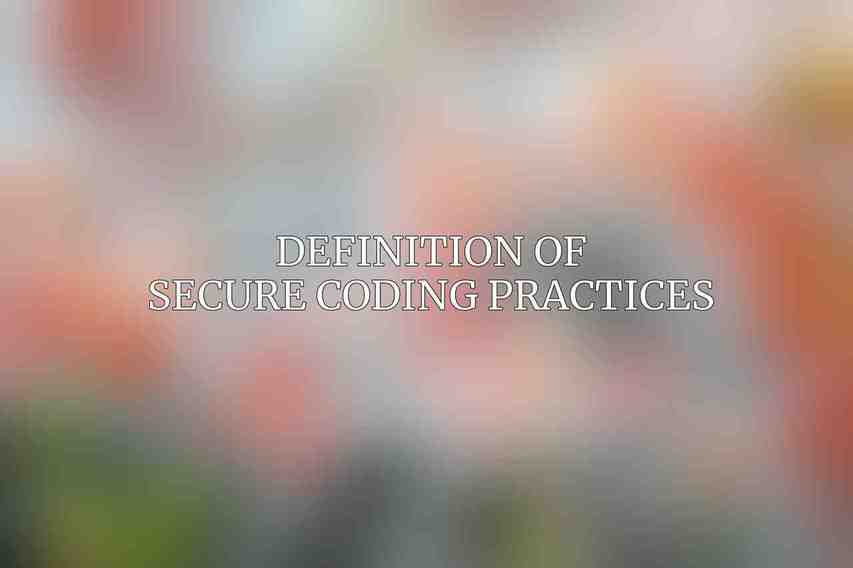Secure coding practices refer to implementing security measures during the development of software to prevent vulnerabilities and protect against potential cyber threats. In the context of website security, employing secure coding practices is essential to safeguard sensitive data, maintain user trust, and prevent malicious attacks.
Definition of Secure Coding Practices

Secure coding practices involve incorporating security considerations throughout the development lifecycle to ensure that software is resilient to attacks and adheres to best security practices.
Why Secure Coding is Important
Ensuring secure code is crucial as websites often deal with sensitive information such as user credentials, financial data, and personal details. Failure to implement secure coding practices can lead to data breaches, financial loss, reputational damage, and legal implications.
Benefits of Secure Coding

- Mitigation of security risks
- Protection of user privacy
- Prevention of data breaches
- Maintenance of compliance with regulations
Challenges of Secure Coding
- Balancing security measures with development timelines
- Ensuring awareness and adherence to secure coding practices among developers
- Addressing the evolving world of cybersecurity threats
Common Web Vulnerabilities and Attacks
When developing websites, it is vital to be aware of common web vulnerabilities and potential attacks that can exploit them. Here are some of the prevalent threats:
Injection Attacks
Injection attacks involve inserting malicious code into input fields to manipulate the application’s behavior. Common types include:
| Types | Description |
|---|---|
| SQL Injection | Executing SQL commands through input fields |
| NoSQL Injection | Exploiting NoSQL databases with malicious queries |
| Command Injection | Injecting system commands through vulnerable inputs |
| XML Injection | Manipulating XML input to attack the application |
Cross-site Scripting (XSS) Attacks
XSS attacks occur when malicious scripts are injected into web pages viewed by other users. Variants include:
- Reflected XSS
- Stored XSS
- DOM-based XSS
Broken Authentication and Authorization
Issues with authentication and authorization can lead to unauthorized access. Common vulnerabilities include:
- Insecure storage of passwords
- Absence of multi-factor authentication
- Authorization bypass techniques
Security Misconfigurations
Improper configuration of web servers and related components can introduce vulnerabilities such as:
- Default or weak passwords
- Insecure file permissions
- Misconfigured web servers
Outdated or Vulnerable Software
Using outdated software or plugins can expose websites to known vulnerabilities. It is crucial to regularly update:
- Third-party plugins
- Core software components
- Operating systems
Secure Coding Techniques
Employing secure coding techniques during development can help mitigate the risk of potential attacks and vulnerabilities.
Input Validation and Sanitization
Validating and sanitizing user input is critical to prevent injection attacks. Techniques include:
- Implementing input validation methods
- Applying sanitization techniques
- Ensuring data types and ranges are enforced
Output Encoding
Encoding output data before rendering it in different contexts prevents XSS attacks. Example encodings include:
- HTML encoding
- JSON encoding
- XML encoding
Safe Coding Practices
Adhering to secure coding best practices can significantly improve the overall security posture of the application. Key principles include:
- Principle of least privilege
- Defense in depth strategy
- Secure by default configurations
Cryptography
Using encryption algorithms and secure communication protocols when handling sensitive data is fundamental. Elements of cryptography include:
- Implementing robust encryption algorithms
- Proper key management practices
- Secure communication protocols like HTTPS
Security Testing
Regular security testing is essential to proactively identify and address vulnerabilities. Testing methods include: Find more on Top Website Security Best Practices for 2024
- Automated vulnerability scanners
- Manual penetration testing
- Code reviews for security flaws
Best Practices for Secure Coding
To enhance website security, developers should adopt best practices in secure coding throughout the development lifecycle.
Develop a Secure Coding Policy
Establishing a comprehensive secure coding policy that outlines security standards and procedures is fundamental for maintaining a secure development environment.
Educate Developers on Secure Coding
Provide training and resources to developers to enhance their understanding of secure coding practices and their importance in safeguarding web applications.
Use Secure Coding Tools and Frameworks
Leverage secure coding tools and frameworks that facilitate secure development practices and help mitigate common vulnerabilities.
Implement Continuous Security Testing
Integrate security testing into the development process to identify and address security issues early on, ensuring the robustness of the application.
Monitor and Update Code Regularly
Regularly monitoring and updating code for security patches and updates is crucial to address emerging threats and vulnerabilities.
Incident Response and Recovery
Establish an incident response plan to effectively respond to security breaches, minimize the impact, and ensure a swift recovery process.
adopting secure coding practices is paramount in enhancing website security and protecting web applications from malicious attacks. By following best practices, developers can mitigate vulnerabilities, safeguard sensitive data, and maintain the trust of users.
Importance of Secure Coding in Protecting Web Applications
Secure coding plays a vital role in fortifying web applications against cybersecurity threats, ensuring the integrity and confidentiality of data.
Benefits of Following Secure Coding Practices
The benefits of implementing secure coding practices extend beyond protection against attacks to include improved compliance, reduced risks, and enhanced reputation.
Call to Action for Developers to Adopt Secure Coding Practices
It is essential for developers and organizations to prioritize secure coding practices, invest in security measures, and stay vigilant against evolving threats to create a safer online environment for all users.
Frequently Asked Questions
What are secure coding practices?
Secure coding practices are guidelines and techniques used by developers to write code that is resistant to vulnerabilities and cyber attacks.
Why is website security important?
Website security is important as it protects sensitive information, prevents cyber attacks, builds trust with users, and ensures the smooth functioning of the website.
What are some common vulnerabilities in websites?
Common vulnerabilities in websites include SQL injection, cross-site scripting (XSS), insecure direct object references, security misconfigurations, and more.
How can secure coding practices enhance website security?
Secure coding practices can enhance website security by reducing vulnerabilities, minimizing the risk of cyber attacks, and ensuring that data remains secure and confidential.
What are some examples of secure coding practices for website security?
Examples of secure coding practices include input validation, output encoding, using secure communication protocols (HTTPS), implementing access controls, regularly updating software, and conducting security audits.

